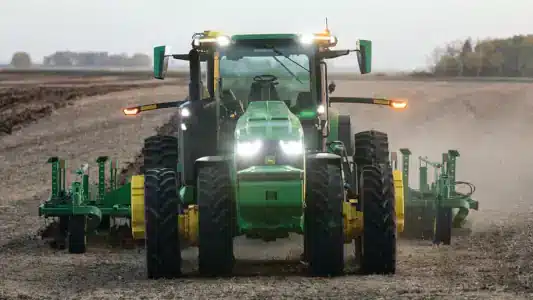Best Practices for Replacing Power Transmission Couplings on Tractors and Combines – A Step-by-Step Guide
Table of Contents
As a farmer, keeping your equipment in top shape is essential for minimizing downtime during peak seasons. Tractors and combines are workhorses on the farm, and when their power transmission couplings wear out, operations can grind to a halt. Knowing how to replace these couplings effectively can save you time, money, and headaches. This guide will walk you through the process step-by-step, providing valuable tips to ensure your farm machinery stays operational.
Understanding Power Transmission Couplings in Farm Machinery
Before diving into the replacement process, let’s first understand what a power transmission coupling does. Couplings are the critical connection between the engine and the machinery’s drivetrain, allowing for the transfer of power. When they wear down, they can no longer efficiently transmit torque, leading to slippage, noise, and eventually mechanical failure.
Some common signs that your tractor or combine’s coupling needs replacement include:
- Unusual vibrations during operation
- A decrease in power output or performance
- Visible wear and tear, such as cracks or corrosion
Now that you know why it’s essential to keep these components in good shape, let’s move on to the actual replacement process.
Step-by-Step Guide to Replacing Power Transmission Couplings on Tractors and Combines
1. Preparation: Gathering the Right Tools and Parts
Before you start, you’ll need to gather the appropriate tools and the correct replacement coupling. For most tractors and combines, the tools you’ll need include:
- Socket wrench set
- Torque wrench
- Screwdrivers
- Pliers
- Rubber mallet
- Grease or lubricant
- Safety gloves and goggles
Choosing the right coupling is essential. Depending on your machinery’s make and model, you might need couplings from well-known brands like Weasler, Neapco, or Spicer. Double-check your manual to ensure you’re getting a compatible part. Investing in an OEM (Original Equipment Manufacturer) part ensures quality, but if budget is a concern, high-quality aftermarket options can also be considered.
2. Safety First: Power Down and Stabilize the Equipment
Safety is critical when working with heavy machinery. Before starting any maintenance work:
- Turn off the engine and ensure all power sources are disconnected.
- Engage the parking brake and, if possible, place the tractor or combine on a flat, stable surface to prevent any unwanted movement during the repair.
- Use wheel chocks to further stabilize the machinery.
Wearing safety goggles and gloves is recommended to protect against flying debris and to avoid direct contact with any grease or oil.
3. Accessing the Power Transmission Coupling
Now that your machine is powered down and secure, it’s time to locate the coupling. This can vary depending on the machine you’re working on. Most tractors and combines house their couplings within the drivetrain near the engine or transmission.
To access it:
- Remove any protective covers or guards that may be shielding the coupling.
- Refer to your machine’s manual to identify the exact location and note any special instructions.
4. Removing the Worn Coupling
With the coupling exposed, you can now begin the removal process:
- Loosen the bolts or clamps securing the coupling to the shaft using your socket wrench.
- Once the bolts are removed, carefully slide the old coupling off the shaft. You may need to use a rubber mallet to gently tap the coupling free if it’s stuck due to corrosion or wear.
- Take a moment to inspect the shaft for damage, rust, or debris. Clean it thoroughly before proceeding.
If the coupling is part of a universal joint (U-joint), additional steps may be required to remove the U-joint assembly before replacing the coupling.
5. Installing the New Coupling
With the old coupling removed, it’s time to install the new one:
- Align the new coupling with the shaft, ensuring it fits snugly in place. Again, a rubber mallet can be used to lightly tap it into position if necessary.
- Reattach the bolts or clamps, but don’t fully tighten them yet.
- Use a torque wrench to tighten the bolts to the recommended specifications as outlined in your machine’s manual. This step is crucial as over-tightening can damage the coupling, while under-tightening can lead to premature failure.
Ensure the coupling is securely in place and properly aligned. Misalignment can lead to uneven wear, reducing the lifespan of the coupling and potentially damaging the drivetrain.
6. Lubricating the Coupling
Proper lubrication is vital for the longevity of your new coupling. Before closing up the machinery:
- Apply a thin layer of grease or lubricant to the coupling and surrounding components. This helps reduce friction and protect against rust and corrosion.
- If your coupling is part of a universal joint, make sure to lubricate the U-joint as well.
Be sure to use the type of lubricant recommended by the coupling or machinery manufacturer for optimal performance.
7. Testing the Equipment
With the new coupling installed and lubricated, it’s time to test the machinery. Before reattaching any covers or guards, briefly run the engine to ensure everything is working correctly.
- Start the tractor or combine and allow it to run at low RPMs.
- Observe the coupling for any unusual noises, vibrations, or movement.
- If everything appears normal, reattach any protective covers and guards.
8. Routine Maintenance for Longevity
Replacing your coupling is only part of the equation. To extend the life of your new coupling, regular maintenance is key.
- Periodically inspect the coupling for wear, especially during peak seasons when machinery usage is high.
- Make lubrication a part of your routine maintenance checklist.
- Keep an eye on bolts and fasteners, ensuring they remain tight and secure.
By performing regular maintenance, you can catch potential problems early and prevent unnecessary downtime during crucial farming periods.
Best Practices for Minimizing Downtime
Replacing a coupling isn’t always a planned event, and downtime can be costly, especially during planting or harvesting. Here are some proactive steps you can take to minimize disruptions:
1. Keep Spare Parts on Hand
Having replacement couplings, bolts, and lubricants readily available can save you time when a coupling needs to be replaced. Many suppliers offer kits that contain all the parts you’ll need for common repairs.
2. Perform Pre-Season Inspections
Before planting or harvesting season, thoroughly inspect your equipment for signs of wear. Replace any worn-out parts, including couplings, before they fail.
3. Train Your Team
If you have farmhands or mechanics working on your equipment, ensure they know how to properly replace couplings. Offering training sessions can empower them to carry out repairs quickly and correctly.
4. Schedule Regular Maintenance
Routine maintenance, including lubrication and bolt checks, should be scheduled during slower periods to prevent unexpected breakdowns during high-demand times.
Best Practices for Replacing Power Transmission Couplings on Tractors and Combines – A Step-by-Step Guide
Keep Your Farm Running Smoothly with Quality Couplings
Replacing power transmission couplings doesn’t have to be a hassle. By following these steps and keeping up with routine maintenance, you can keep your tractors and combines running efficiently throughout the year. At twinspringcoupling.com, we offer a wide range of high-quality OEM and aftermarket couplings from trusted brands like Weasler, Spicer, Neapco, and more. Visit our online store today to stock up on replacement parts and keep your farm machinery operating at peak performance.

